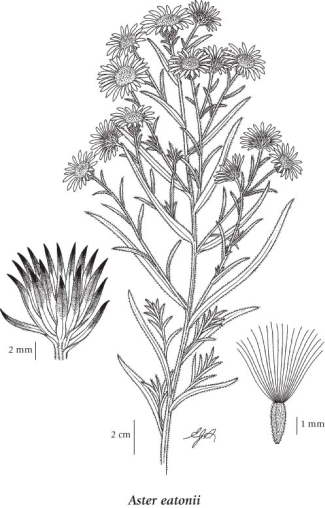Click on the image below to view an
expanded illustration for this species.

|
General:
Perennial herb from a creeping rhizome; stems erect to ascending, minutely and uniformly hairy, 0.4-1.0 m tall.
Leaves:
Basal leaves mostly deciduous by flowering time; stem leaves linear to lanceolate, unstalked, glabrous to short, rough-hairy, 5-15 cm long, 4-20 mm wide, often with shorter, linear axillary leaves.
Flowers:
Heads with ray and disk flowers, numerous in a relatively narrow, branching inflorescence; involucres 4.5-10 mm tall; involucral bracts oblanceolate to spoon-shaped or the inner ones linear, abruptly sharp-pointed, often loose, fringed below, glabrous on the backs, the leafy tips of the outer ones longer than the pale base and spreading; ray flowers 20-40, white, pink or rarely lavender or blue, 5-12 mm long; disk flowers yellow.
Fruits:
Achenes several-nerved, sparsely hairy; pappus white.
Notes:
This species was treated as Aster bracteolatus by Douglas (1989, 1995) based on the examination of the type specimen by Dr. K.L. Chambers (Dean and Chambers 1983). More recently, Dr. G.A. Allen (1993, pers. comm.), retained the use of A. eatonii since there is still confusion as to which taxon the type specimen actually represents.
Source: The Illustrated Flora of British Columbia
|
